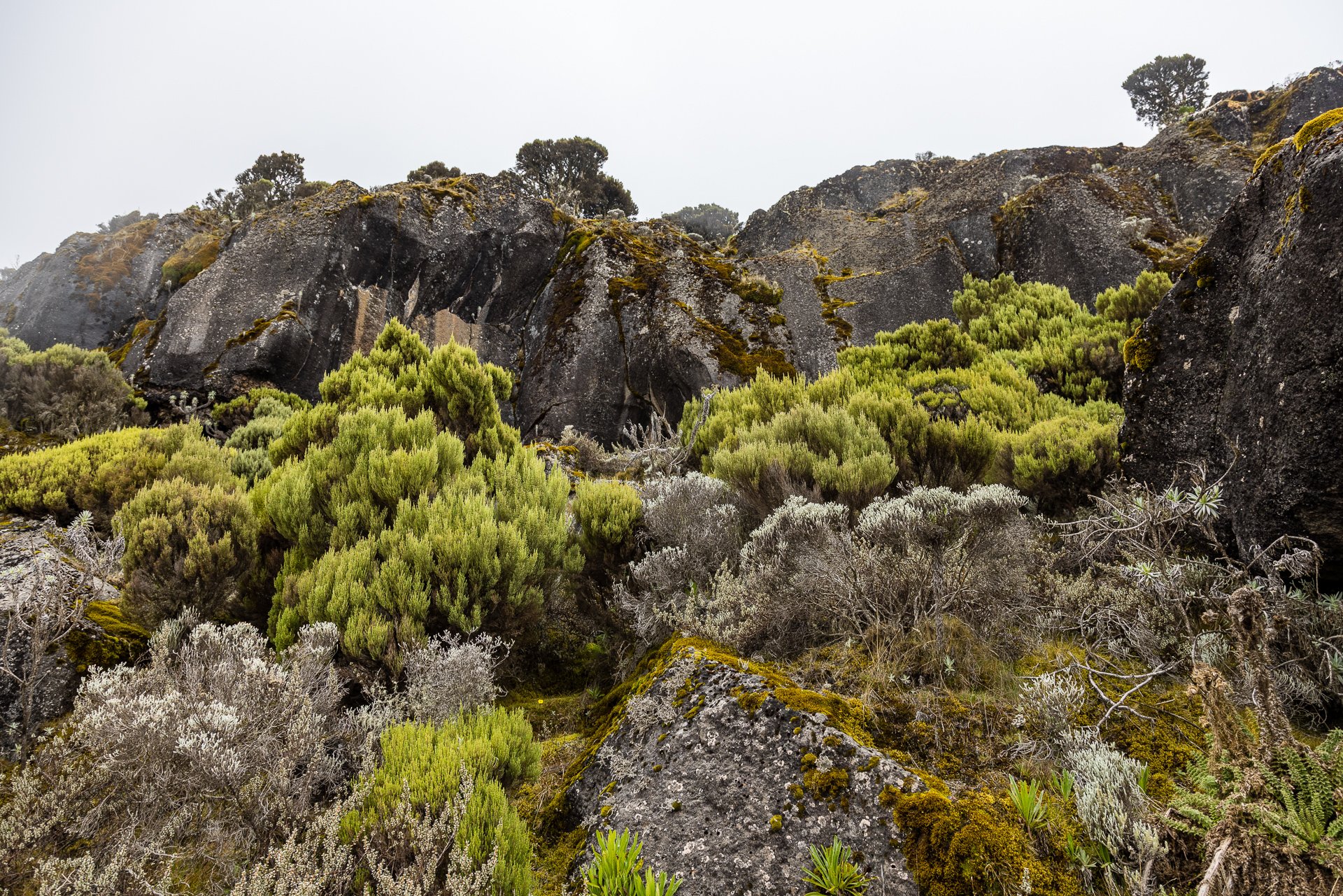02 Machame Camp - Shira Camp
Trail Information
Distance: 5km
Difficulty: Hard but short
Transport: From Shira Camp there is a road. If you are having issues with the climb, this is the easiest point to turn back.
Terrain: Kilimanjaro spans five ecological zones. Each day progresses through one or more of them.
-
Where people live, work and farm. this is the main altitude of Tanzania.
-
Mountain forests and evergreen. Heavy rainfall and high humidity.
-
The start of lower oxygen and stranger flora. There is little tree cover and the change from rainforest to moorland is both dramatic and obvious.
-
You will see some real changes in your body at this altitude, very few animals and plants live at this level.
-
Hail, snow, freezing winds are all possible. Nothing lives at this altitude. Rocks and stones are your only friends.
Machame to Shira rapidly leaves the rainforest zone and spends the majority of the time in the Moorland.
Accommodation & Shopping
Machame Camp
Altitude: 2,850 meters
Machame is nestled in the forest, and so is quite free from wind. It also is layed out in clearings and so each group has some small level of privacy from each other.
Machame has a few toilet blocks and even a few seated toilets. Enjoy it, as its the last you will see for a week. You’ll need to be brave as well, as its generally not that clean.
Sights
Shira Cave
A small cave used by porters for years instead of bringing their own tents.
The Experience
Day 02
An early morning wakeup from one member of the team, as he came around taking our drink orders. Whilst they were being prepared, we had time to pack up our bags. Still unpractised, my coffee arrived before I was finished and so i left its somewhat precariously balanced outside my tent so I had the space and freedom to finish bagging everything up in the dry-bags. Breakfast was at 7am and was a mix of millet porridge, sausages, eggs and pancakes with more coffee. Solid hearty food to keep us going.
After fulling our water, we set off promptly at 8am, one one of the more challenging days, only five kilometres in distance but a solid 1000km ascension, with a 100m drop at the end for acclimatisation.
Very quickly the scenery changed from rainforest to something more alien, as we moved out of one zone and into the next. Peculiar trees, unusual cacti and an occasional white throated crow were around the trail. Very few sections were flat and the climb varied from almost ‘steps’ to the occasional scramble over rocks.
We ended up in three groups, fast, medium and slow. The main difference between fast and medium was not pace but length of breaks. Even our fastest hikers were kept at a fairly gentle pace by the CEOs and the constant reminder of ‘pole pole’, Swahili for ‘slowly, slowly’. There’s nothing that can guarantee you won’t be affected strongly by altitude sickness, but your best changes come from following the guides and going slower than you think is necessary, earlier than you think you should.
One of our pauses was by a rocking outcropping that a few of us climbed for photos and the view. Looking back over our day and a few hours of hiking, the scenery was spectacular, the monotonous rainforest that blocked our views was lush and beautiful see from above. To one side, occasionally occluded by clouds, the distant peak of Kilimanjaro rose above us, our destination and motivation.
As we stood on the rock, clouds began to roll in across the temperate rainforest, almost like a breaking wave. Looking ahead, we could see the trail cut into the wilderness, and regularly we’d be passed by porters carrying their heavy loads.
Later on the trail, after more climbing, we paused at a small cave, with more incredible views back over the trail. After a snack and water break, we climbed more, reaching on of the peaks we would be climbing before dropping down to camp. On the peak, a few drop toilets could be found, as well as a number of ravens.
White Throated Raven
We were about 3,500m up at this point and I was really noticing the altitude. The climbs themselves were not that tough. Bohusleden in Sweden has some much more challenging sections than we’d faced today, but the lower oxygen had us all breathing heavily.
The Diamox and the guides insistence we drink at least 3 litres of water a day had me ‘pissing like a racehorse’ every chance I got, at least every hour if not more frequently. In theory this was helping to flush out the alkaline from my system that builds up due to the reduced oxygen.
Shira Camp
There was little to see on the highest point of the days trail, and from there it was a short walk down to where we were camping. Shira Camp is basic, but has a well tiled and constructed drop toilet block, which gets rinsed down regularly as people tramp dirt and mud into the cubical. Nearby a helipad is marked in stone on the ground. The campsite has great views over the peaks, though gets very foggy. We reached our campsite by 12:30, and so it was a fairly short day, though a challenging one. We had lunch whilst we waited for the slower hikers to get to camp. Soup, followed by meat, pasta and a sauce that was filling. All made of ingredients that are light and easy to prepare.
Our tents were already setup when we arrived, but i paused for coffee before I ‘unpacked’ my tent. As I was unpacking the heavens opened and so i slipped on my rain-jacket and joined the others in the main tent for hot drinks and conversation. We parked some of the more controversial areas of discussion. As a talkative toaster once said three things you should never discuss. “Religion, Politics and Toast”
Some of the crew went to their tents to nap, I stayed in the main tent with my journal and chatted to one of the CEOs.
In theory, a nature walk was planed for 16:00, but with the rain still coming down at 15:30, it was looking unlikely. However, with a 30 minute delay, we went out a short distance to Shira Cave. Where porters, as many as 50 of them, would sleep, cutting turf from the plain and bringing it in to sleep on (Gradually increasing the height of the cave floor and reducing the headroom. Outside they’d create a campfire, which occasionally lead to wildfires. A few serious wildfires lead the government to ban sleeping in any of the caves, requiring everyone to bring a tent and no one to make a campfire.
One our walk back to camp, the rain started again, and we gathered in the tent for the daily health check and info for the following day. Before dinner, Gibson, one of the CEOs gave a lecture on Kilimanjaro.
Kilimanjaro
CEO Gibson
There are four principals to climbing Kilimanjaro eveyrone should know.
Drink water: At least 3 liters a day
Eat even if you don’t want to: Your appetite will reduce as you get higher, but you need the energy
Pole Pole: Walk slowly. Its not the height that gets you, its the altitude.
PMA: A Postive Mental Attitude will get you to the top.
‘Tomorrow will come and go’
Before 1973, Kilimanjaro was a game reserve, in 1973 it was established and in 1977 it was made a National Park. The Chaga Tribe live at the bottom, and in distant times past would sacrifice goats on the mountain.
No one knows where the name “Kilimanjaro” comes from, but there are two prevailing theories.
Chaga: Kili Ma (small hill) - jiaro (growing up)
Maasi: Kilima (small hill) - Jarai (of water)
Editors Note: Ultimate Kilimanjaro lists a further few options for where the name comes from.
There are three peaks on the mountain of Kilimanjaro.
Shira Peak: 3,962 meters high.
Mowenzi: (which needs a permit to climb) at 5,149 meters and it used to be higher
Kibo: 5,892 at Uhuru Peak. The highest of the three and our destination.
At one point, a torch was carried from village to village through Tanzanai and then on to the highest point. That marked its remaning into the Swahili Uhuru (Freedom) Peak from its previous German name.
Kibo errupted 100,000 years ago, as a massive explosion forming barranco wall, a 300m escarpment we’d be climbing later in the trail.
Scientists estimate that Kibo may errupt once more in 20+ years, whilst it is domant it shows occasional signs of waking.
The ‘first’ persont to climb Kilimanjaro, or at least the first person recorded in European documents was Hans Meyer, who took three attepts on the now considered ‘easier’ Marenge route, he reached Gillmans point twice and then with the help of a local guide, he reached the top. Editors Note: The more perceptive among you would no doubt ask how the guide knew the route past Gillman’s to the peak if Meyer was first.
There are seven routes to the top of Kilimanjaro, each with their own advantages.
Machame: Our route and one the sout side. 6-7 days to complete and with a high proportion of successful hikers. Also known as the ‘whiskey route’
Lemosho: Sometimes called the most beautiful route, its also the ‘slowest’ taking 8-10 days. It gives teh longest time to acclimatise, but joins with Machame for the most challenging ascent.
Shira: Older than Lemosho, which was craeted as a ‘better’ alternative, it starts at Shire Gate, 3,300 meters high and so is only recommended for those previously acclimatised looking for a rapid ascent, though 7 days is a typical climbing time. One member of our crew who needed to head down from Shira Camp took the access road.
Rongai: The only northern route. Its well sheltered so a good option for those climbing during the rainy season. 7-8 day climbing time.
Northern: One of the newest routes, and the longest, taking 9-11 days. Its one of the safest trails for acclimatisation time.
Marangu: The Coca-Cola route is for those looking for a little luxury. It will be a ‘little’ luxury. Marangu offers huts at its camps. Its considered the gentlest route and the most popular with families. 7 days.
Arrow Glacier: Closed due to the danger of collapsing glacial ice, the occsaional experienced alpinist will be given permission to climb after signing the relevant disclaimers. The world record holder for ascending Kilimanjaro took combined route, including the Arrow Route, Karl Egloff, who made it in just 6 hours and 42 minutes.
Between Gibson’s talk and dinner, we had time to watch the sunset, though it was cloudy it was still remarkable.
Dinner was fantastic, a local chicken sauce which reminded me so much of Nigerian food. After dinner, the crew surprised me with a birthday song and a huge cake for all of us. After eating cake and feeling really quite touched, I took a few star shots and felt ready for bed, at 21:30. Reading for a while and trying to ignore all the camp noises around us.
Total Distance: 5km
Altitude Gained: 960 meters



























